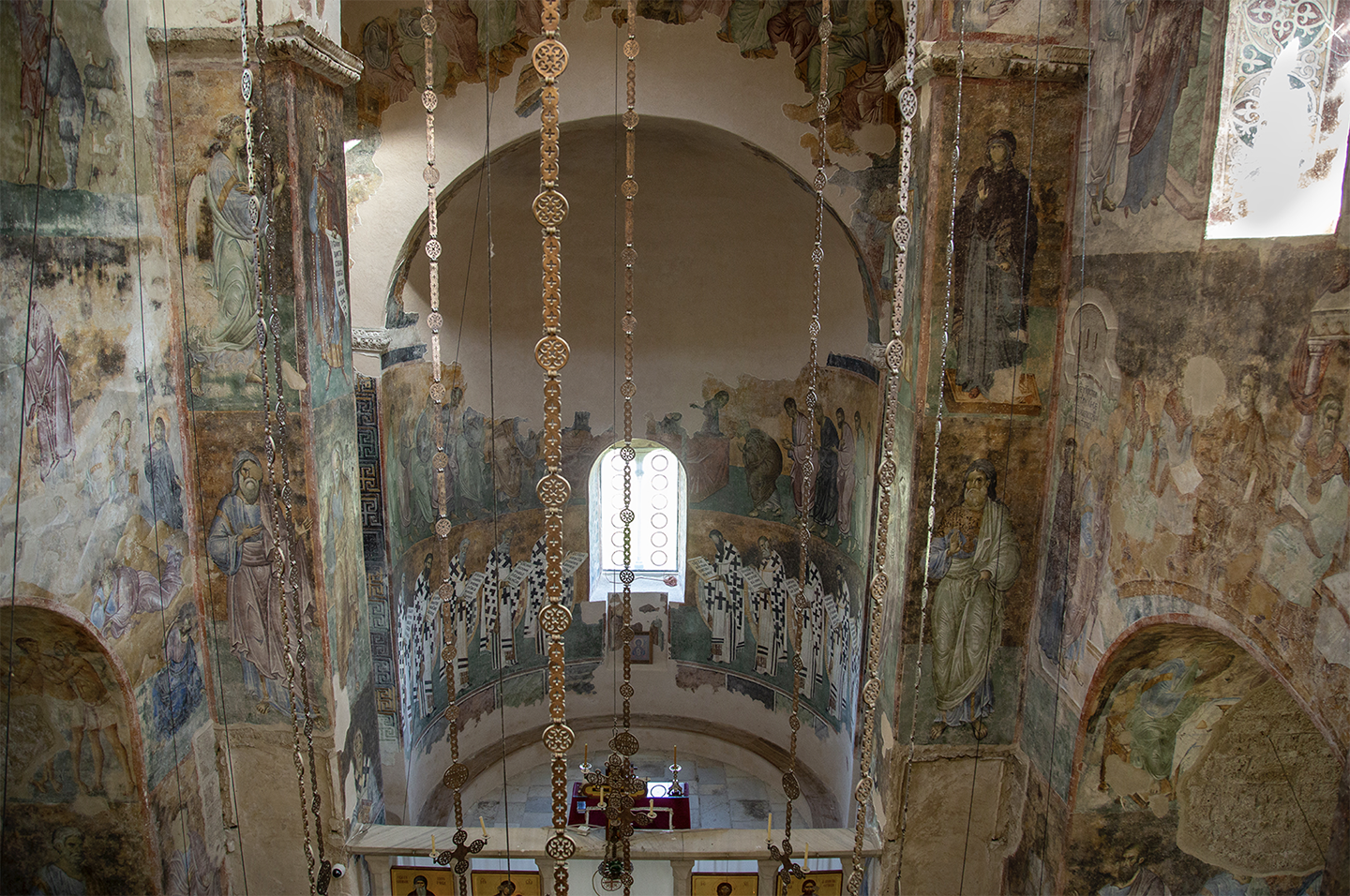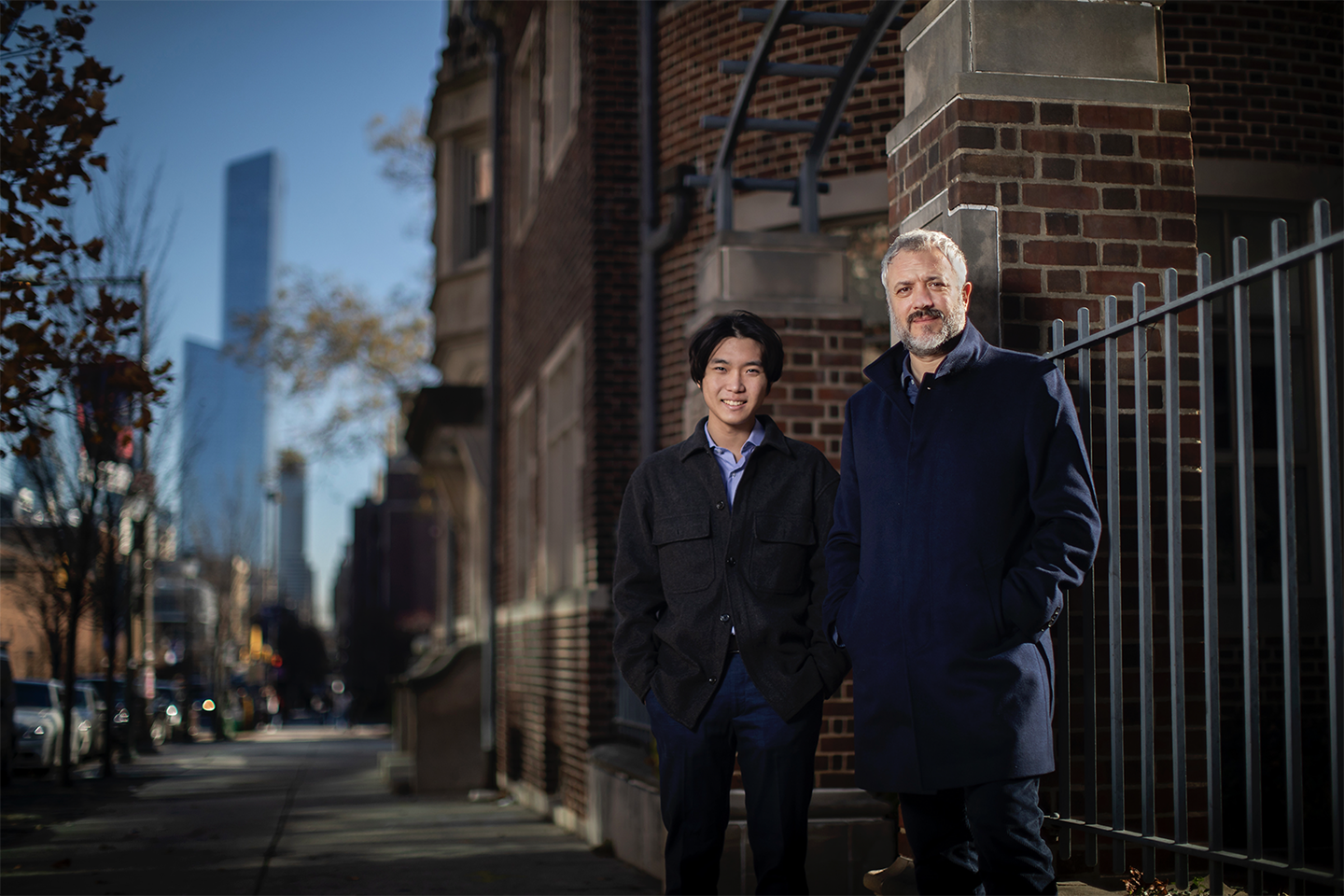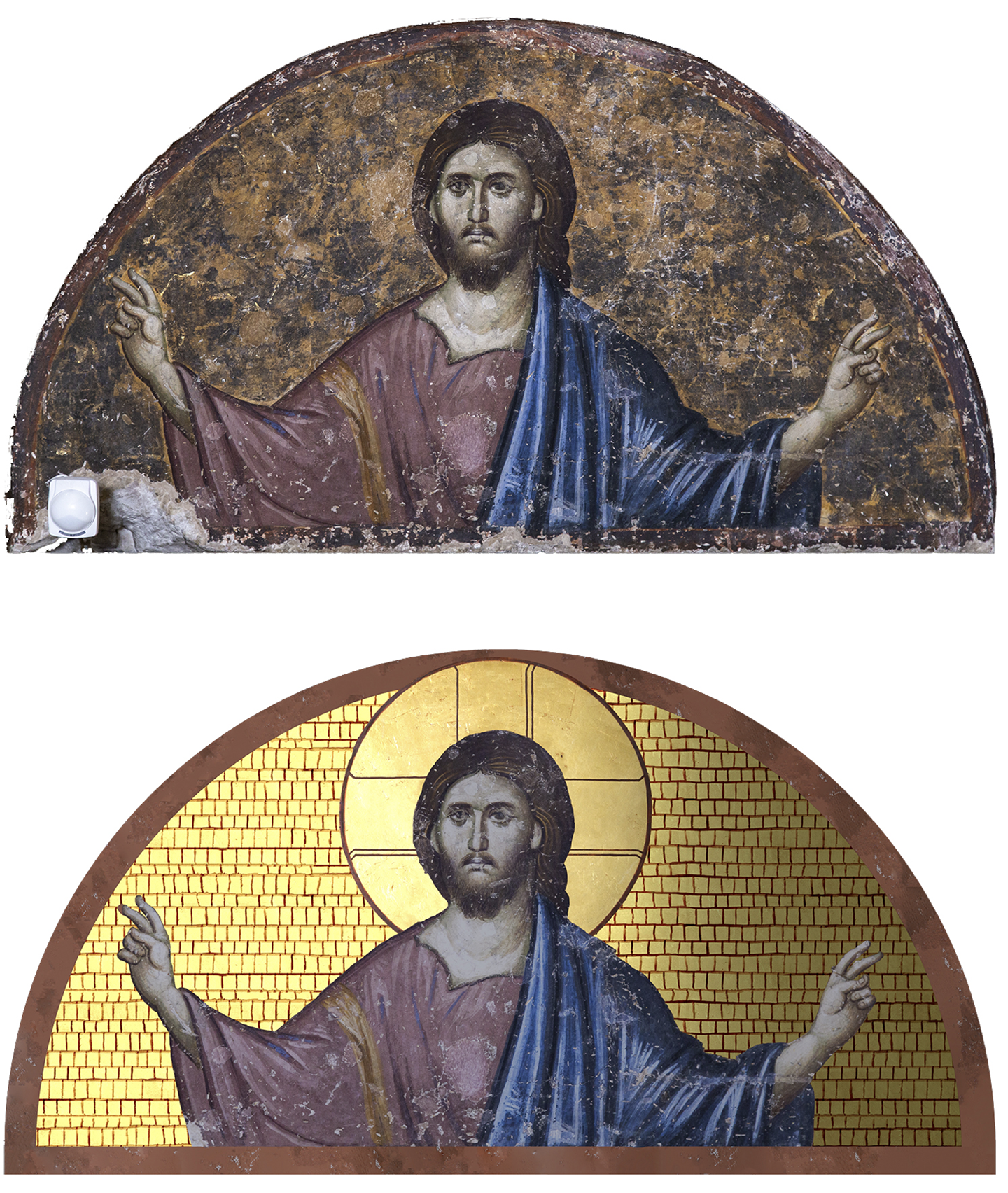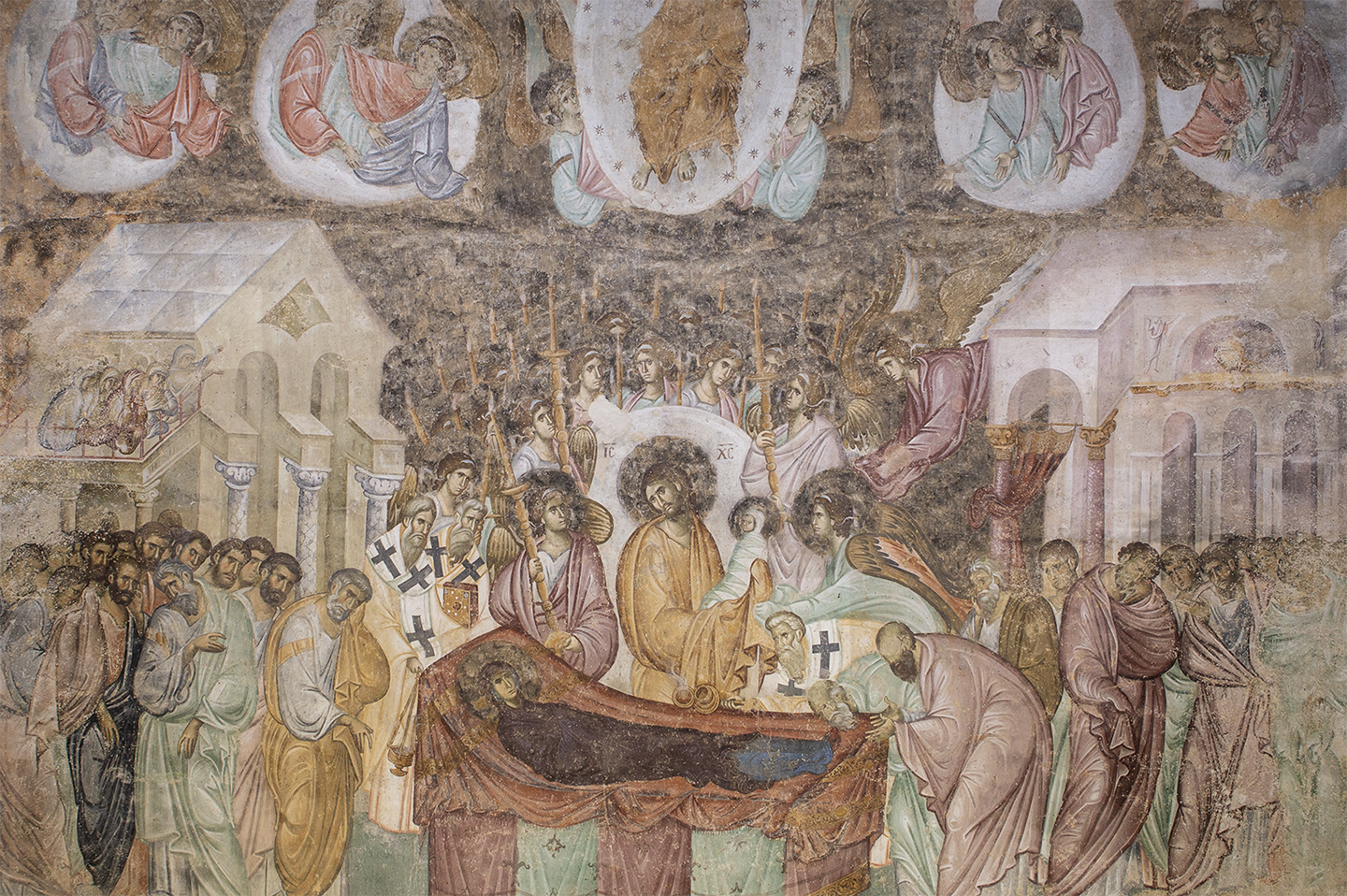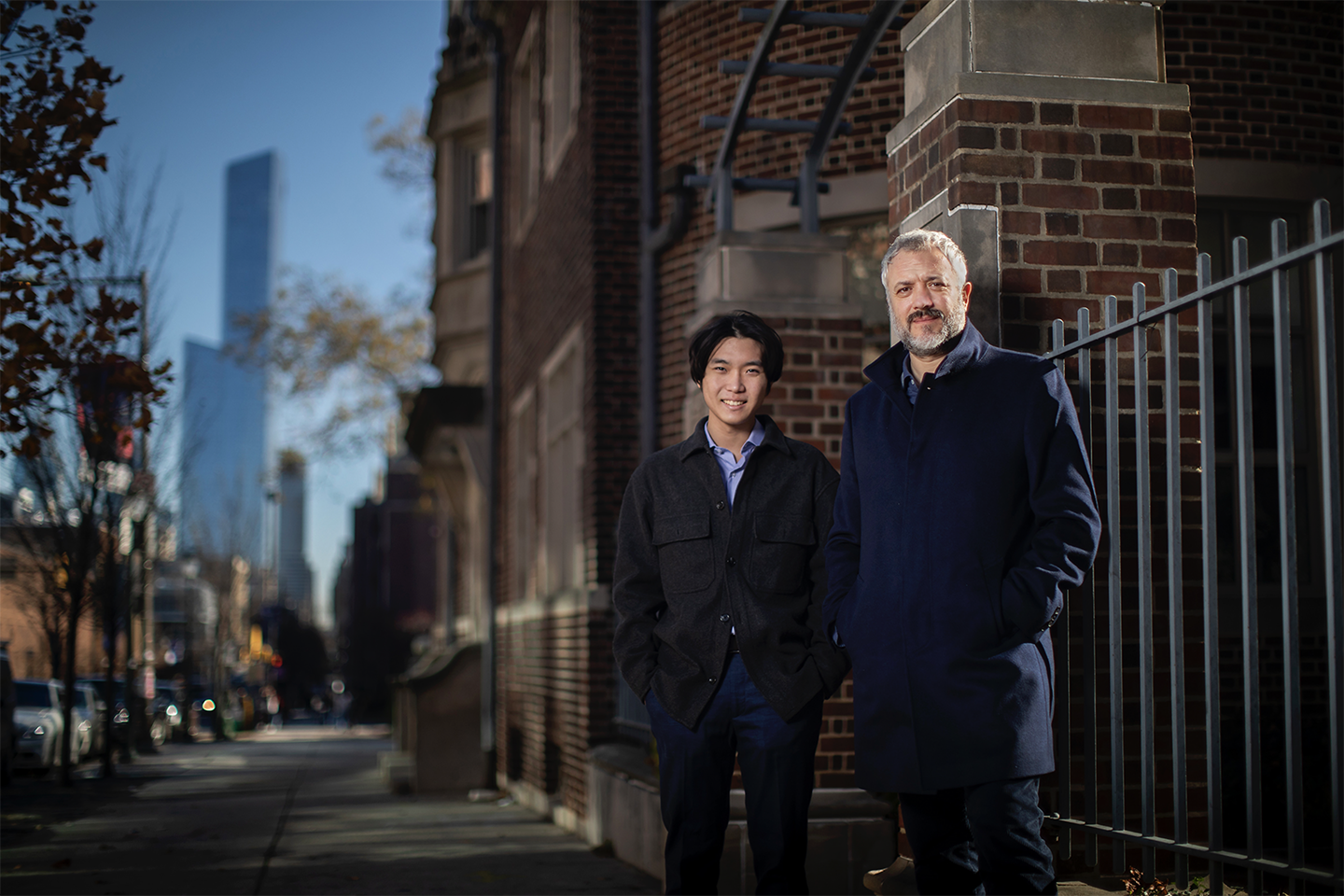
Ivan Drpić (right), associate professor of the history of art in the School of Arts & Sciences, with sophomore Logan Cho, who is in the Digital Design Program in the School of Engineering and Applied Science.
February 22, 2022
Envisioning Gold: History of Art’s Ivan Drpić is working with sophomore Logan Cho to create 3D renderings of what once-gilded paintings on the walls of a medieval church in Serbia would have looked like.
By Louisa Shepard | Photographs by Eric Sucar | Penn Today | February 21, 2022
Staring at the faded frescos in a medieval church in Serbia, University of Pennsylvania’s Ivan Drpić wondered what it must have been like 700 years ago, when the paintings were gilded with gold leaf and the sunlight streamed through colored glass windows.
An associate professor of art history, Drpić decided to try to find out by using the latest technologies in digital computer design, something he knew absolutely nothing about. He brought on a summer intern, sophomore Logan Cho, and they have been working together ever since, discovering how to use modern techniques to reimagine a medieval structure.
“As historians we often are trying to imagine, to visualize, the experience of artworks in the past. This is important for us to understand these artworks, to understand their meaning, why they were made, how they were understood,” Drpić says.
“And so the question is, what do you do with monuments with artworks that are poorly preserved and not in their original state? This is where computer graphics can help us get to that experience, that original appearance of things,” he continues. “So this would be ultimately our goal, to try to see what this interior, what these paintings, looked like once they were made, to try to reconstruct the gilding by using the digital tools we have today.”
Cho, from Auckland, New Zealand, is in the Digital Media Design Program in the School of Engineering and Applied Science. He found the paid summer internship with Drpić through Penn’s Center for Undergraduate Research & Fellowships, and he has continued working on the project as an independent study throughout this academic year.
Although he says the project has turned out to be more complicated than he anticipated, Cho says he has benefitted in many ways, finding contacts in his new major, gaining digital design skills, and creating a tangible product to demonstrate what he has learned.
“Having a project of my own that I did a lot of the initial research for and found my way through is one of the biggest driving points for me,” says Cho. “My experience with this project solidified for me that this work is really fun, and it has been helpful in confirming for me that I want to go down this path.”
Michael Leja, chair of Penn’s History of Art Department, says Drpić “has been brilliant at making cultural materials that may seem remote or esoteric instead vivid and vital for 21st-century students and scholars.
“His collaboration with Logan takes this commitment in a new direction by seeking to provide a visceral visual experience of a once-dazzling interior that has lost key elements of its appearance,” says Leja, a professor of art history. “Such challenging work has the potential to yield fresh understandings of important Byzantine monuments and to galvanize a new generation of scholars in art and architectural history.”
Research discoveries
Born and raised in Serbia, Drpić earned his undergraduate degree from the University of Belgrade before coming to the United States for his master’s degree and Ph.D. at Harvard. He specializes in the art, architecture, and material culture of Byzantium, the medieval civilization that flourished from the 4th to 15th centuries in the eastern Mediterranean. His focus is southeastern Europe with an emphasis on the period from the 11th through 15th centuries.
Drpić started research into five monastic churches in Serbia just after he joined Penn’s faculty in 2017. He wanted to explore what he says is “an interesting phenomenon that is well-known, but never properly studied” in the pictorial decoration of the churches at Studenica, Mileševa, Sopoćani, Gradac, and Banjska, all founded by members of the Serbian royalty.
The most prestigious art form for monumental church decoration at that time was mosaic, which was expensive and required a specialized workforce, he says. The rulers in Serbia in the 13th and early 14th centuries pursued an alternative to mosaics by having artists paint figures on the walls, gild portions of those paintings with gold leaf, and then score the gold with a pattern to mimic mosaic cubes, he says.
“The problem with this technique of gilding over painting is that it is extremely fragile and it deteriorates,” Drpić says. “Now the gold is gone, completely disintegrated, but what remains is a trace of the mosaic pattern.”
Embarking on the research project in the summer of 2018 with funding from a School of Arts & Sciences Research Opportunity Grant, Drpić collaborated with chemist Aleksa Jelikić and a conservator to examine the gold leaf. They worked on the research for two years, resulting in a technical study, “On large-scale gilding and mosaic simulation in medieval Serbian wall painting,” in the peer-reviewed journal Archaeometry.
“We figured out that it was gold leaf that also uses silver, which is very, very unusual,” Drpić says. “We also figured out that they were using special glues or adhesives that were also unusual because they created a very shiny, polished surface to imitate the brilliant appearance of gold mosaics.”
The gold leaf, they discovered, was laminated, he says, made with two sheets, one of gold and one of silver underneath. The approach was possibly even more expensive than mosaic cubes, he says, because the gold leaf had to be thicker to apply to the wall and to hold the scored pattern.
“It is my guess that they were unable to secure a skilled workforce to do the mosaic, and they resorted to this alternative,” Drpić says.
Gold mosaic cubes have an extremely thin, less than a micrometer, layer of gold leaf sandwiched between two layers of glass. “The surface of the mosaic is reflective; each of these cubes is like a little mirror. And this affects a very rich, very luminous surface, which is why mosaics were so valued at the time,” Drpić says. “This is the kind of art that really interacts with the environment and light plays a very important role.”
The second part of the research project, he says, is a historical study based on the technical data, to place it in the original context to understand what it means to have this kind of decoration, as well as how it relates to other historical practices and the larger world at the time. Drpić expects this study to be published later this year.
Digital reimaginings
While conducting the research in Serbia, Drpić had a professional photographer take high-resolution images of the interior of the Holy Trinity at Sopoćani church, and also had a digital 3D scan made of the building, so he could pursue the third and final part of the research project: the digital reconstruction. The painted decoration of that church is, despite major losses, the best preserved of the five, he says.
“Because the gilding is gone, we only have these battered walls with very faint traces of original mosaic pattern,” he says, noting that the silver tarnished, leaving dark smudges where the gold used to be.
Drpić last year submitted a proposal to the Penn Undergraduate Research Mentoring internship program, specifically for freshmen and sophomores. Cho was looking for a research opportunity for the summer, especially since he was not planning to return home to New Zealand after moving to campus in January of 2021.
“I had no research experience at all and so I was really attracted to the fact that it was no barrier to entry for freshman and sophomores,” Cho says, noting that he was overwhelmed by the choices, especially since he was doubting his choice of a mechanical engineering major. “I was thinking robotics research or graphics research.” He searched those words and the first on the list was Drpić’s project. “It literally hit just what I was looking for.”
The two met mostly virtually, but were able to get together in person in the latter half of the summer. At first Cho conducted research on various computer programs. He also got permission to use the SIG Lab for Computer Research, which accelerated his progress.
“I know very little about computer design,” Drpić says. “I really had to rely on Logan’s knowledge and his experience to not simply implement my ideas, but also to understand what is possible, what can be done.”
Cho is using the images and scans of the church to create a 3D video rendering that makes it seem like the viewer is moving through the church and focusing on the paintings, which are of religious figures. “The goal, which we are still working towards, is to essentially use these digital tools to visualize what originally the interior looked like to try to get to the experience of somebody entering this church in the middle of the 13th century, the whole church, to the extent that we can do it, because not everything is preserved,” Drpić says.


